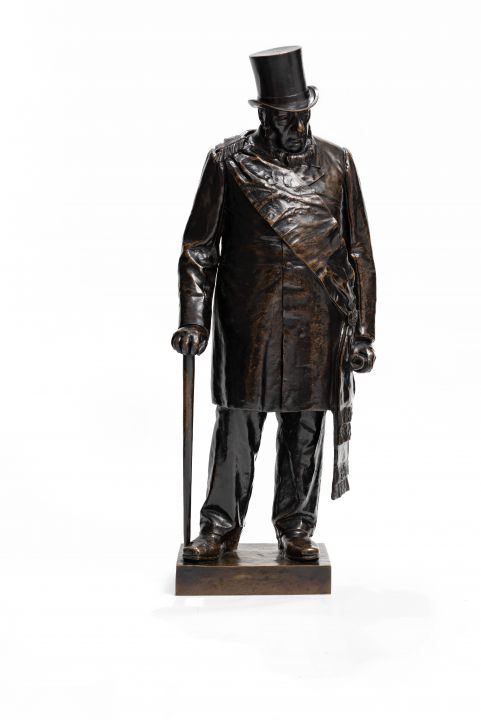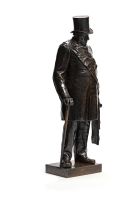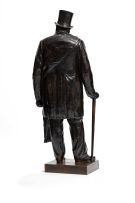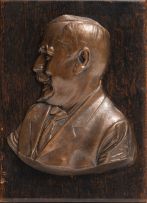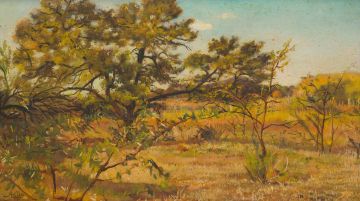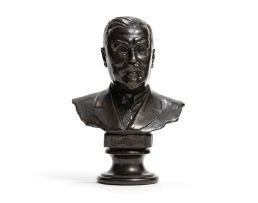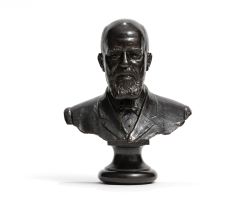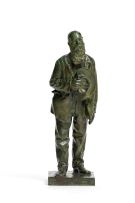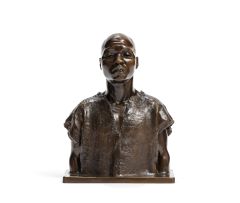Paul Kruger
Anton van Wouw
Incl. Buyer's Premium & VAT
About this Item
bears the foundry mark
Notes
Few South African sculptures have as rich a provenance as the imposing, time-burnished bronze maquette for the Paul Kruger Monument. Fewer still are so entwined in the histories of the Transvaal Republic; its folkloric, top-hatted president; the Second Anglo-Boer War; and the backroom, helter-skelter, treasure-bargaining years before the Union. It is also remarkable that such an item, forever in private hands, should now go on view to the public for the first time in well over a century.
In 1895, Sammy Marks (1844-1920), the shrewd entrepreneur and Kruger confidant, provided the necessary funding to erect a permanent monument to the Transvaal's president in Pretoria's Church Square. His enormously generous gift of £10 000 would first-and-foremost cover the production costs of the statue, while any excess would go towards public improvements for the city. Such a prestigious public commission naturally caught the attention of Anton van Wouw who, incidentally, having arrived in the Transvaal in 1890, lived on the same street at the president. He quickly set to work on a small-scale model of the monument to be considered by Marks, the Pretoria City Council, and Kruger himself. This model is well-known from a number of contemporary photographs, and it clearly pleased the president: Van Wouw was awarded the commission in October 1897.
The artist's concept was grand, ambitious, and in the spirit of the finest public monuments of early modern Europe. Bringing to mind Pietro Tacca's Monument of the Four Moors (1626) in Livorno, for instance, Van Wouw's design set Kruger atop a slender, square-edged pedestal, and placed four Boer soldiers on a quadratic base below, each of them crouching and armed. Four high-relief panels were also to be set into the sides of the plinth.
While initially considering a studio in Holland, Van Wouw eventually modelled each of the five major figures in Rome over a number of months between 1897 and 1898. Each was colossal. The squatting Boer soldiers - a pair of contemporary types, and a pair from the Great Trek - stood 7ft high, while Kruger measured a full 14ft in his boots and top hat. The casting in bronze was left to the master Roman foundryman, Franciscus Bruno. By the time Van Wouw arrived back in Pretoria late in 1898, the monument's base and pedestal had been prepared. Due to the outbreak of war some months later, however, the completed bronze figures, as well as the four accompanying relief panels, were impounded in Delagoa Bay, their enormous crates loaded into the warehouse of the London-registered African Boating Company. With Pretoria under British sway, and the guerrilla Boers forever on-the-run, Kruger's monument seemed doomed.
Sensing an opportunity, Lord Kitchener of Khartoum (1850-1916), the British chief-of-staff, negotiated the appropriation of the bronzes with Sammy Marks, and arranged to have the four Boer figures redirected to England. The Kruger figure languished in the Delagoa Bay warehouse (although rumours persist that this original casting was dumped in the Bay). While Kitchener planned to split the Boer soldiers between Sandhurst and Woolwich military colleges, one pair was eventually installed at the School of Civil Engineering at Chatham, and the other in the gardens of Broome Park, Kitchener's country seat: spectacular spoils of war.
In 1914, a decade after Kruger's funeral in Pretoria, his statue was returned to the city and lifted atop a lone plinth in Princess Park. Despite Louis Botha's best diplomatic efforts, the Boer soldiers remained in Britain for a generation; only in the aftermath of WW1 did Jan Smuts facilitate their return to South Africa. After being repatriated late in 1921 (Kitchener had died in 1916), the four soldiers were finally reunited with their general in 1925, when all were installed together outside the old Pretoria Railway Station. Finally, in 1956, the monument was positioned in its intended location in Church Square, albeit upon an amended base.
When modelling the five figures in Rome, Van Wouw made a number of small amendments. In the final version of Kruger, for instance, he changed the figure's weight distribution and the position of the presidential sash; the walking stick was added too, and the beard pressed more firmly against the collar. This definitive maquette was probably cast in plaster in Rome, and captured in an image by Rudolf Steger. It was exhibited at the Pretoria Art Association's inaugural exhibition in October 1904, and it formed part of the memorial decorations at the president's Pretorian funeral in that December. Thereafter it was acquired by Sir Ernest Oppenheimer, and returned to Rome pre-1907 to be cast in bronze. Only a single casting was made by the Nisini foundry before the plaster was destroyed. This astonishing, solitary casting, with its deep caramel patina, was purchased by the Rand Club in Johannesburg from Sir Ernest for 125 guineas. At the entrance to the bar for generations, Oom Paul - regal and weighty - has enjoyed a unique view of the country's history.
The maquette has been identified by SAHRA as an item of significant historical importance, and will not be issued an export licence.
Provenance
Sir Ernest Oppenheimer.
The Rand Club, Johannesburg.
